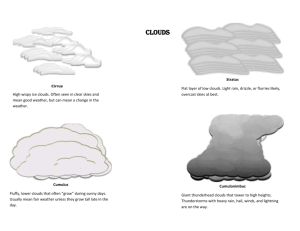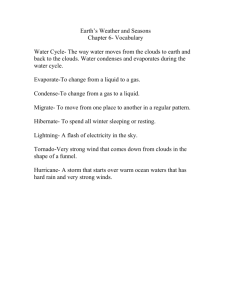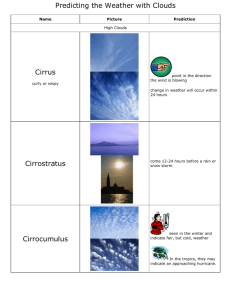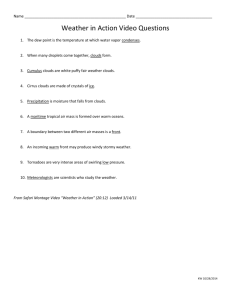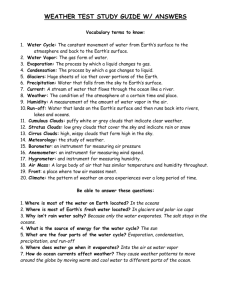Activity Write Up Bio106
advertisement
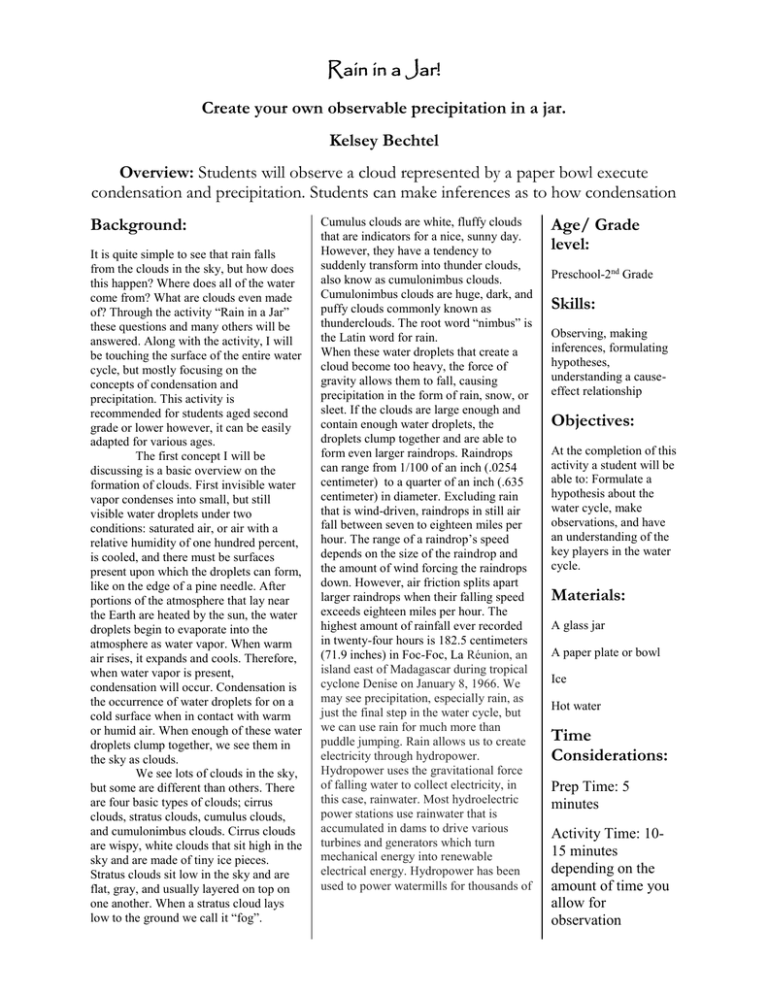
Rain in a Jar! Create your own observable precipitation in a jar. Kelsey Bechtel Overview: Students will observe a cloud represented by a paper bowl execute condensation and precipitation. Students can make inferences as to how condensation Background: It is quite simple to see that rain falls from the clouds in the sky, but how does this happen? Where does all of the water come from? What are clouds even made of? Through the activity “Rain in a Jar” these questions and many others will be answered. Along with the activity, I will be touching the surface of the entire water cycle, but mostly focusing on the concepts of condensation and precipitation. This activity is recommended for students aged second grade or lower however, it can be easily adapted for various ages. The first concept I will be discussing is a basic overview on the formation of clouds. First invisible water vapor condenses into small, but still visible water droplets under two conditions: saturated air, or air with a relative humidity of one hundred percent, is cooled, and there must be surfaces present upon which the droplets can form, like on the edge of a pine needle. After portions of the atmosphere that lay near the Earth are heated by the sun, the water droplets begin to evaporate into the atmosphere as water vapor. When warm air rises, it expands and cools. Therefore, when water vapor is present, condensation will occur. Condensation is the occurrence of water droplets for on a cold surface when in contact with warm or humid air. When enough of these water droplets clump together, we see them in the sky as clouds. We see lots of clouds in the sky, but some are different than others. There are four basic types of clouds; cirrus clouds, stratus clouds, cumulus clouds, and cumulonimbus clouds. Cirrus clouds are wispy, white clouds that sit high in the sky and are made of tiny ice pieces. Stratus clouds sit low in the sky and are flat, gray, and usually layered on top on one another. When a stratus cloud lays low to the ground we call it “fog”. Cumulus clouds are white, fluffy clouds that are indicators for a nice, sunny day. However, they have a tendency to suddenly transform into thunder clouds, also know as cumulonimbus clouds. Cumulonimbus clouds are huge, dark, and puffy clouds commonly known as thunderclouds. The root word “nimbus” is the Latin word for rain. When these water droplets that create a cloud become too heavy, the force of gravity allows them to fall, causing precipitation in the form of rain, snow, or sleet. If the clouds are large enough and contain enough water droplets, the droplets clump together and are able to form even larger raindrops. Raindrops can range from 1/100 of an inch (.0254 centimeter) to a quarter of an inch (.635 centimeter) in diameter. Excluding rain that is wind-driven, raindrops in still air fall between seven to eighteen miles per hour. The range of a raindrop’s speed depends on the size of the raindrop and the amount of wind forcing the raindrops down. However, air friction splits apart larger raindrops when their falling speed exceeds eighteen miles per hour. The highest amount of rainfall ever recorded in twenty-four hours is 182.5 centimeters (71.9 inches) in Foc-Foc, La Réunion, an island east of Madagascar during tropical cyclone Denise on January 8, 1966. We may see precipitation, especially rain, as just the final step in the water cycle, but we can use rain for much more than puddle jumping. Rain allows us to create electricity through hydropower. Hydropower uses the gravitational force of falling water to collect electricity, in this case, rainwater. Most hydroelectric power stations use rainwater that is accumulated in dams to drive various turbines and generators which turn mechanical energy into renewable electrical energy. Hydropower has been used to power watermills for thousands of Age/ Grade level: Preschool-2nd Grade Skills: Observing, making inferences, formulating hypotheses, understanding a causeeffect relationship Objectives: At the completion of this activity a student will be able to: Formulate a hypothesis about the water cycle, make observations, and have an understanding of the key players in the water cycle. Materials: A glass jar A paper plate or bowl Ice Hot water Time Considerations: Prep Time: 5 minutes Activity Time: 1015 minutes depending on the amount of time you allow for observation years to create everyday products such as flour. In the year 2006, hydroelectric power supplied nearly twenty percent of the world’s electricity. We may see precipitation, especially rain, as just the final step in the water cycle, but we can use rain for much more than puddle jumping. Rain allows us to create electricity through hydropower. Hydropower uses the gravitational force of falling water to collect electricity, in this case, rainwater. Most hydroelectric power stations use rainwater that is accumulated in dams to drive various turbines and generators which turn mechanical energy into renewable electrical energy. Hydropower has been used to power watermills for thousands of years to create everyday products such as flour. In the year 2006, hydroelectric power supplied nearly twenty percent of the world’s electricity.
